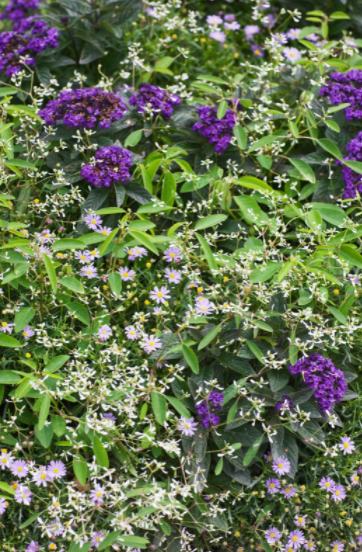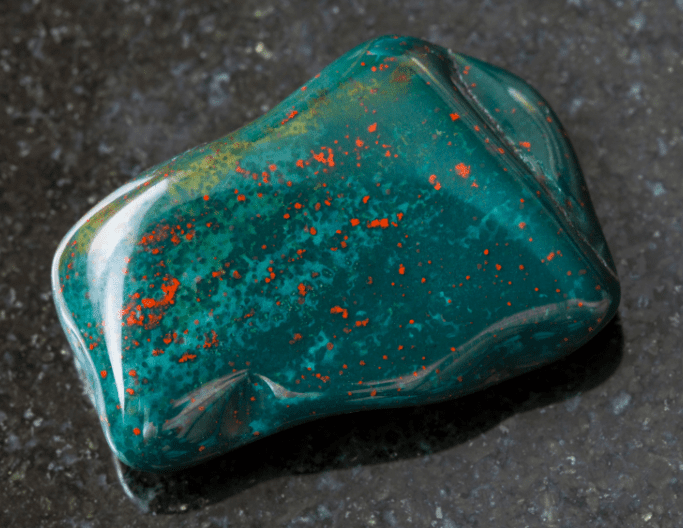Bloodstone
Heliotrope flowers were once worn fresh, alone or with a bloodstone, with the belief that they had the power of shielding a person from detection, as Dante alludes to in his Inferno:
“Amid this horrifying exuberance of woe, Ran naked spirits winged with ghastly fear, Nor hope had they of the crevice to hide, Or heliotrope to charm them out of sight.”
For Swiss peasants, edelweiss, hazelnuts, and Ascension Day amaranth wreaths were supposed to grant one the ability to vanish from sight when worn. At the same time, in the Tyrol, mistletoe was credited with this property.
The beautiful blue hooded flower of the highly toxic perennial aconite, also known as monkshood, or wolfsbane, represents the cap of darkness in Norse mythology, which enables its wearer to become invisible at will and also forms part of Odin’s attire.
Herbal potions designed for this purpose were not uncommon. One recipe suggests steeping poppy seeds in wine for 15 days, then drinking a bit of this wine daily during a five-day fast, to accomplish this extraordinary feat when required.
None can surpass the fern seed’s but of all the plants valued through the centuries to confer invisibility.
Legend states that only on the Eve of Midsummer (June 21) can these magical seeds, or spores, be obtained. One must sit among the ferns in complete solitude and await their flowering at midnight.
Some describe the flowers as globes of sapphire blue, while others claim they are ruby red. The seeds appear a few moments later, glowing like `molten gold’ in the dark.
They should not be gathered or shaken from the plant but allowed to fall onto a white cloth; that is, if one can manage to escape Oberon’s watchful eye that night, as he stands guard to prevent these precious seeds from falling into mortal hands.
Victorians loved heliotrope for its intoxicating fragrance, described by David Stuart and James Sutherland in “Plants from the Past” (Viking), as “a mixture of almonds, vanilla, lemons and perhaps some cloves.”

The flowers are not much to sneeze at, either, the broadly rounded clusters, a blending of lavender-blue or all-white florets that individually resemble those of a lilac.
In Victorian gardens and conservatories, heliotrope reached the height of artistic perfection. Through the years, the plant has undergone extensive development.
Hybrids are now available in tall, graceful models for outdoor bedding that also make excellent standards or semi-dwarfs fit for a pot indoors or on the terrace.
Especially worthy varieties are Marine and Purple Bonnet. In Europe, heliotrope is used in making perfume.
Unable to resist a gorgeous specimen in a 5-inch pot I stumbled onto at Bittersweet Hill Nurseries in Davidsonville, I brought it home to try in a window.
The plant has continued to blossom there, but it also, alas, developed a fungal infection that causes the leaves to go brown and wither. The blight attacks if the soil remains too moist.
Hildreth Morton, the owner of Bittersweet Hill, says that when leaves begin to wither, cut the plant back by one-third, move it if it has grown more significant to a pot two sizes larger, and replenish the soil.
The plant will develop an excellent root system, which will reduce the frequency of the need for watering. Cuttings without flowers or buds may be rooted. Plants are also propagated by seed or layering.
Heliotrope is technically a perennial. But because it is susceptible to frost, it must be grown annually in areas where frost occurs.
The name heliotrope means “turning toward the sun in Greek.” Plants displaying such behavior are generally termed heliotropic. In the language of flowers, heliotrope stands for devotion.
Tumbled bloodstone: Bloodstone (also known as heliotrope) symbolizes inherited wealth and the earned wealth that keeps a family prosperous. It helps to remove obstacles and promotes dedication.
Red jasper polished egg: Cover the polished red jasper stone with some soil of your house to promote a solid competitive edge, stamina, and willpower. Keep these stones covered and, as you polish them, focus your mind on your intention to sharpen your wits and attain success.
Tumbled black onyx: Place it in the right-hand drawer, a powerful protection stone; it absorbs and transforms negative energy. It also helps the development of emotional and physical strength and fosters wise decision-making.
Tumbled tiger eye: It is calming and reduces stress. If you are nervous about doing a presentation or an interview, keeping a piece of this crystal in your pocket can help you relax.
Raw red aventurine: Position this crystal in your office as a sort of shrine to future prosperity, where you can handle the crystals as you periodically meditate on each phase of making your dreams come true.
Keep these crystals in a glass bowl with some water anywhere near the desk for maximum output.
Uses in Feng Shui
Activate Zhen in the New Beginnings Area
The Zhen region of the Feng Shui Bagua, known as New Beginnings or Family, is about getting new projects. Clearing out stagnant energy and blocks is a must to start new projects.
To help you surpass any obstacles that may be preventing you from moving forward, it might be a good idea to place bloodstone at the Zhen position in your home. Imagine a grid three by three (similar to a tic tac board) placed over your bedroom or home.
Zhen is the middle section of the grid that you see when you stand in front of your bedroom or home door.
Activate Dui. The Completion Area
On the Bagua map, Dui is located opposite Zhen. It is also known as Completion or Children. Sometimes it can be challenging to keep motivated and complete new projects.
You might consider activating the Dui area in your home if this is something that you have trouble with. Imagine the grid being laid across your bedroom or home. Dui will be located in the middle of the grid.
You can place a bloodstone in this area with the intent of encouraging you to stay focused on your project and persevere in achieving your goals.
Activate Tai Qi in the Health Area
Tai Qi is the center of the Bagua Map. It’s linked to overall wellbeing. It touches all Bagua areas surrounding it because it is in the middle. Your wellbeing has a profound effect on every aspect of your life.
Tai Qi is, therefore, a critical foundational area. Tai Qi can help you feel grounded if you are feeling unsupported. Bloodstone is a grounding and calming rock that can help us stay present. It can also be beneficial in Tai Qi.
To activate this area of your home, place a bloodstone there to support your grounding, centering, and strength goals.
Activate Li in the Recognition Area
The fire element is also connected to the Li area of the Bagua (also known as Recognition of Fame). Fire is associated with passion, inspiration, and seeing. Fire is the most active element of the five elements.
Red is an expression for the fire element. Bloodstone’s red flecks are a sign of this fire element. Bloodstone is also linked to the wood element because it contains green. Wood feeds the fire in the five elements cycle.
Therefore, both fire and wood elements are supportive of Li’s position. Imagine a grid three by three laid across your front door. Then, locate Li. To attract more fire element qualities such as visibility and inspiration, you can place bloodstone in Li’s position.




























